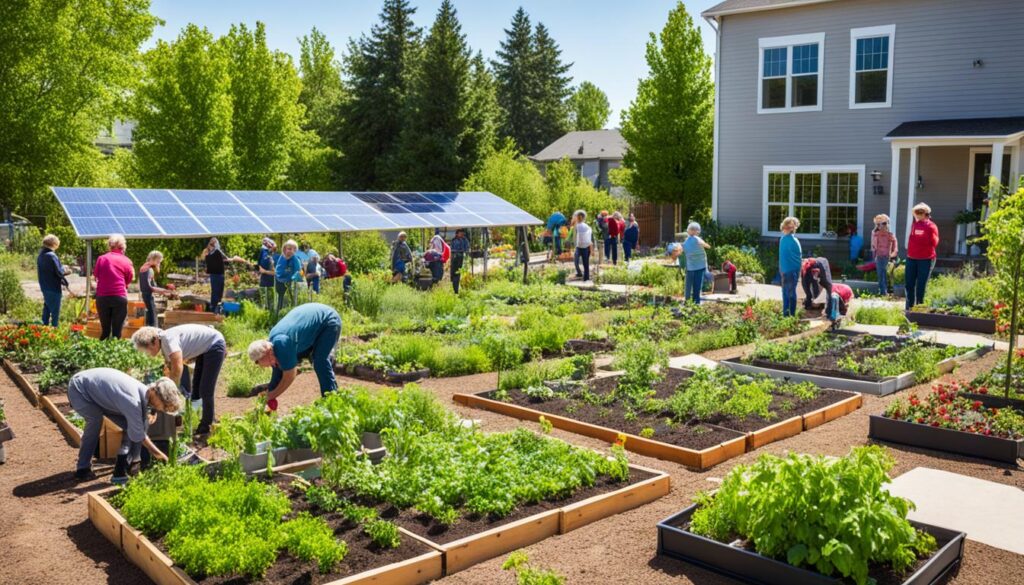Green Empowerment is a nonprofit working on sustainable solutions worldwide. It was inspired by Benjamin Linder. He was an engineer from Oregon killed in 1987 in Nicaragua, working on a project. This project focuses on more than just energy. It also includes water, sanitation, and community empowerment1.
Their efforts have led to great success. Ninety-seven percent of the sites checked in 2021 are still operating well. They’ve helped 15 schools and trained teachers and staff to keep their places clean. They’ve also educated teachers from 56 schools on menstrual hygiene and handwashing. Additionally, they’ve given out hygiene kits to schools and held a contest to promote menstrual hygiene in 13 schools, with the help of Water For People – Peru1.
Green Empowerment’s collaborative approach is making real changes worldwide. For example, in Malaysia, their project at Puneng Trusan is supported by TONIBUNG and Seacology. They’ve also worked with communities in Colombia, teaching them about the costs and sustainability of their water systems over 30 years1.
Key Takeaways
- Green Empowerment is a nonprofit organization dedicated to creating sustainable solutions for communities around the world.
- Their work focuses on building community-scale energy, water, and sanitation systems to empower rural and underserved populations.
- The organization has achieved a high operational success rate of 97% for its energy and water projects installed between 2009 and 2019.
- Green Empowerment’s programs have improved infrastructure, provided hygiene education, and distributed kits to schools in Peru, Colombia, and Malaysia.
- The organization’s holistic approach to sustainable development is making a lasting impact in communities globally.
Introduction to Green Empowerment Programs
Green Empowerment is a trailblazing non-profit, working since 1997 to uplift communities through sustainable projects2. It partners with locals, letting them decide the best solutions for their issues2. This method ensures each area gets help that fits their unique situation.
Origins and Mission
This group started after Benjamin Linder, an American engineer, lost his life working on a hydro project in Nicaragua2. His passion inspired the birth of Green Empowerment. Its goal is to help communities solve their own problems in green ways, focusing on energy, water, and protecting the environment.
Approach to Sustainable Development
Green Empowerment puts creating sustainable jobs and better clean energy and water access at the forefront3. It partners with locals to find what each area needs. Then, they might build micro-hydro power systems, use solar, or work on preserving local watersheds4. The work is owned by the community, making it last and growing their power along the way.
This organization loves to share knowledge, too3. It joins with schools and companies to teach ‘green’ skills. This is so communities can keep their eco-projects going well3.
“Green Empowerment’s community-driven approach ensures that the solutions are locally owned and maintained, fostering long-term sustainability and community empowerment.”
Green Empowerment Programs’ Global Reach
Green Empowerment is a standout in international development, reaching communities in Latin America, Asia, and Africa5. Since starting in 1997, it has improved life for those with little, focusing on clean energy, water, and sanitation5.
Their work spans many countries, from the U.S. to Sierra Leone. They focus on urgent needs, becoming a leading force in their area5.
Access to clean water is a top priority for the organization5. Shockingly, 2.2 billion people don’t have safe drinking water, and 4.2 billion lack clean sanitation5. Green Empowerment has helped over 7,000 people in Peru alone get better drinking water5.
They also help with energy needs, creating small, affordable power systems6. Working with locals and groups in Southeast Asia, they’ve boosted many lives6.
Their impact is vast and growing, thanks to a focus on teamwork and sustainability56. They’re facing global challenges head-on, helping communities thrive.
Community-Scale Energy Solutions
Green Empowerment Programs’ main goal is creating lasting, small-scale energy solutions. They tackle the tough issues faced by distant and off-grid places. Their work shines through by bringing reliable and eco-friendly energy to these areas7.
Microgrids and Minigrids
Green Empowerment Programs focuses on setting up microgrids and minigrids. These energy systems are spread out and give power to houses, medical centers, and schools in far-off spots. They don’t rely on the usual power grids. This gives the people in these places the ability to run their own energy setups. This makes sure their systems can work for a long time and they become more independent7.
Micro-Hydro and Solar Power Systems
Besides the microgrids and minigrids, Green Empowerment Programs also installs micro-hydro and solar power systems. These systems are made to meet each community’s specific energy needs8. They use local resources to provide constant electricity, lessen hard work for the locals, and offer jobs. The central focus is on letting the local people lead in planning, running, and keeping up these energy systems.
These creative projects are really changing the game in getting renewable energy to more hands. Green Empowerment Programs is helping off-grid communities step into their energy future. They are moving towards a world where everyone plays a part789.
“By empowering communities to develop and manage their own energy systems, Green Empowerment Programs helps to ensure long-term sustainability and self-sufficiency.”
Water, Sanitation, and Hygiene (WASH) Initiatives
Green Empowerment Programs work hard to help communities with clean water and energy. They put a lot of focus on water, sanitation, and hygiene (WASH) projects. These projects are very important for making sure people have clean water, good sanitation, and follow good hygiene10.
Community Water Systems
They help local areas build and look after their own water systems. They set up things like community water systems and rainwater gathering. By giving communities the tools to handle their water, they help these projects last a long time10.
In a recent event, Green Empowerment got Water Committee members from six areas together. They talked about the best ways to do things and got to see new ideas10. Staff from five different nations were at the event. They also met with two new partners, Fundación Halü and Fundación Suyusama10. They looked at successful projects in Ecuador and Nicaragua as examples. These projects helped them figure out how to make new efforts better and bigger10. Plus, Benaville Nagudi from Uganda checked out the work in Colombia. This visit helped spread the program to more places10.
Sanitation and Hygiene Education
Green Empowerment is not just about building water systems. They also teach about good hygiene and how to keep clean. They do this to help improve health and happiness in the areas they serve11.
For many years now, the USAID/WASHPaLS project has been a big help. It runs from 2016 to 2022 and works on sharing the best ways to keep water places clean and help people wash hands more often11. This project got help from groups like Tetra Tech, Aquaya Institute, FHI 360, and FSG. They also gave out grants to help teach people to change their hygiene habits in different countries11.
Another big project is the WASH Alliance International (WAI). Their goal is to provide clean drinking water for over 266,300 people by 2022. They also aim to help with toilets for more than 388,500 people and improve hygiene habits for 198,900 people by the same year12. The WASH SDG Consortium, thanks to a 59 million euros donation from the Dutch Government, works on making water and sanitation better for everyone. Their focus is to support Goal 6, which is about clean water and sanitation for all12.
By working on water, sanitation, and hygiene, Green Empowerment makes communities stronger. They aim to fix problems with local solutions to improve public health10.
“Empowering communities to manage their own water resources is at the heart of our WASH initiatives. We believe that sustainable change can only come from within, and that’s why we work hand-in-hand with local leaders to develop and maintain these vital systems.”
– Jessica Tanner, Green Empowerment Programs’ WASH Coordinator
Empowering Rural Communities
Green Empowerment Programs focus on empowering rural communities. They team up with local partners for this. Together, they train locals and help them acquire the tools needed for their sustainable projects13. This boosts their ability to be self-sufficient in the long run.
Around 75% of the world’s impoverished live in rural areas. They depend on farming for their living13.
Capacity Building and Training
Sustainable development must come from within a community. That’s why Green Empowerment Programs teach and support locals in various skills. They help in project management, technical knowledge, and community organization13. This way, communities are ready to manage their own projects, like forestry and clean energy ventures.
The New ERA program is a big push for rural electrification. It’s a $9.7 billion effort, the most since 193614. This scheme offers loans, grants, and zero percent interest for specific projects. It focuses on lowering greenhouse gases and helps areas in need the most14.
Green Empowerment Programs strongly believe in the power of education and training. By supporting communities, they enhance their development efforts. This not only makes life better for rural folks but also boosts the country’s economy13.
“Empowering local communities to lead sustainable development efforts is crucial for achieving long-term environmental, social, and economic goals.”15
Green Empowerment Programs
Green Empowerment is a nonprofit organization focused on sustainable solutions worldwide1. It works on energy, water, and sanitation. It also trains rural people to build their own tools for success1.
The group teams up with local folks to match their work with communityneeds1. This close teamwork leads to lasting results. It’s a positive change for many in need1.
Empowering Rural Communities
Green Empowerment helps rural areas learn to help themselves. It teaches locals how to use and keep their new systems1.
- In Sarawak, Malaysia, a Micro Hydro Project is helping thanks to Green Empowerment and TONIBUNG1.
- In Colombia’s Ipiales, six water systems are getting a needed update with Green Empowerment’s help1.
The training they provide makes sure communities can take care of themselves. Their projects keep helping, even after Green Empowerment leaves1.
Expanding Reach and Impact
Green Empowerment doesn’t just help one place. It has projects in many countries. For example, in Peru, their work in schools has made a big difference:
- Water For People – Perú has helped improve toilets in 15 schools in the La Libertad District1.
- 137 teachers in 56 schools got a lesson about keeping clean thanks to Water For People – Perú1.
- Hygiene kits were shared with 56 schools1.
- The Christadelphian Meal a Day of Americas supported efforts for better menstrual hygiene1.
Their work shows how much they can do. Green Empowerment makes a big, positive change around the world1.
They are driven by working closely with communities. Their commitment to local empowerment and creative solutions makes a big impact. They are a leading light in the effort for a better world1.

“Green Empowerment’s community-driven approach to sustainable development is making a tangible difference in the lives of people around the world.”
Partnerships and Collaborations
Green Empowerment Programs’ success is centered around their strong network of partners. This network spans the globe. They work closely with local and international partners to bring sustainable solutions to rural areas16.
They have teamed up with over a dozen organizations worldwide. These include El Comun and UTA in Colombia, and Soluciones Prácticas Bolivia in Bolivia. They’ve also partnered with ATDER-BL, FEDICAMP, Cacaonica, and many others in Nicaragua. These partnerships make their work effective and impactful17.
Their partnerships help find solutions that fit each community’s needs. This way, their projects match the local culture and really help people. It’s all about working together with the locals to make a real difference16.
| Partner Organization | Location | Key Initiatives |
|---|---|---|
| Yamog Renewable Energy Development Group, Inc. | Philippines | – Completed 10 micro hydro projects and 21 solar projects by 202217 – Provided renewable energy access to 4,000 households through an EU-backed project17 |
| Sibol ng Agham at Teknolohiya (SIBAT) | Philippines | – Built 30 community-based micro-hydro systems across the Philippines by 202217 – Worked with Green Empowerment on electronic load controllers and load management devices17 |
In the US, their base is in Portland, Oregon. This location strengthens their local and community partnerships. It’s a hub for their work worldwide16.
“The partnership with Green Empowerment is rooted in mutual respect and shared vision of community-based development,” said Nonoy from Yamog. “SIBAT also expressed appreciation for Green Empowerment’s consistent support and quality networking.”17
As they grow, they keep focused on their partnerships. They know that working together is key to making lasting change. They value the role of teaming up with others towards a better future17.
Impact and Success Stories
Green Empowerment Programs’ work has changed many lives for the better18. They’ve made sure communities get clean energy, water, and sanitation. They also help in saving the environment and creating jobs through sustainable projects18.
They use things like micro-hydro and solar power18. Their efforts make communities stronger. They can shape their own future in a better way.
One success is about funding green projects18. There was a project to build a solar power plant in a small town. But, getting money was hard from regular places18.
Luckily, they found help from new-minded investors and groups18. With this help, the solar plant got built. It created jobs, cut down on pollution, and saved nature18.
Green Empowerment also works on turning waste into energy19. These projects have been growing. More people are looking to solve waste and energy issues19.
Waste-to-energy helps economies and the environment19. It turns trash into power, which is good for the earth. New tech makes this process better19. And, governments are now more open to supporting these efforts19.
Their work doesn’t stop with power and waste. They also help with green infrastructure20. More than 600 people have learned from them. They’ve helped build things like rain gardens20.
These projects clean up a lot of rainwater20. They help keep the environment safe. This program shows that communities can do a lot to protect nature20.

Green Empowerment is really changing things. They help communities get clean ways to live and work. Their work is making our future better for everyone181920.
Conclusion
Green Empowerment Programs is leading the way in sustainable development. It focuses on community-led projects and protecting the environment. This approach is making a difference in the areas it supports21.
This organization is making waves globally. It uses new ideas in sustainable growth. By helping young people lead in protecting the Earth and supporting women in clean energy, it’s changing the world2122.
Green Empowerment is vital in our fight against climate change and social problems. It puts sustainable projects and community support first. This is guiding us towards a stronger, fairer future for all23.
FAQ
What is Green Empowerment Programs?
What is the mission of Green Empowerment Programs?
What are the focus areas of Green Empowerment Programs?
Where does Green Empowerment Programs work?
What are the community-scale energy solutions developed by Green Empowerment Programs?
What are the water, sanitation, and hygiene (WASH) initiatives of Green Empowerment Programs?
How does Green Empowerment Programs empower rural communities?
What is the global impact of Green Empowerment Programs?
How does Green Empowerment Programs collaborate with partners?
Source Links
- OUR IMPACT | Green Empowerment
- Fresh Faces at Green Empowerment | Green Empowerment
- Empowering the Workforce: The Significance of Green Skills and How to Attain Them
- Trailblazing Sustainable Energy: Milestones on the Sabah Roadmap
- SDG 6 Clean Water & Sanitation | Green Empowerment
- SDG 17 Partnership for the Goals | Green Empowerment
- DOE Awards Over $2 Million Towards Community-Driven Clean Energy Projects Through SOLVE IT Prize
- Sustainable Energy for all: making a case for community-scale micro-hydro as the solution – International Rivers
- Who We Are – Energy Solutions
- Water Solutions Without Borders | Green Empowerment
- Water, Sanitation, and Hygiene Partnerships and Learning for Sustainability
- Water, Sanitation and Hygiene (WASH) – RUAF Urban Agriculture and Food Systems
- Community empowerment – Farrelly Mitchell
- Empowering Rural America New ERA Program
- Empowering Local Communities for Sustainable Development.
- Partnerships – United Nations Sustainable Development
- 20 Years of Partnership in The Philippines | Green Empowerment
- Empowering Renewable Energy: A Success Story of Affordable Funding
- Empowering Communities: The Social Impact of WtE Initiatives
- Youth for Green: Empowering the Next Generation in Environmental Advocacy
- Empowering Women for a Sustainable Energy Future | Global Energy Alliance for People and Planet
- Empowering Local Communities: Building Stronger and Sustainable Future

